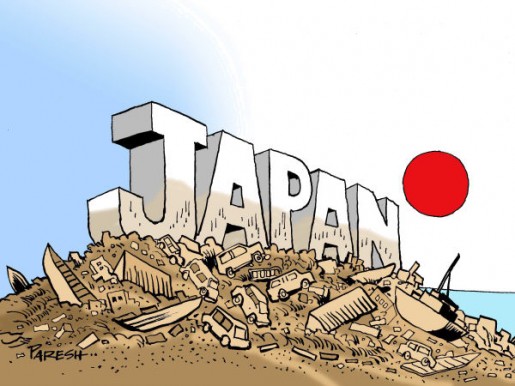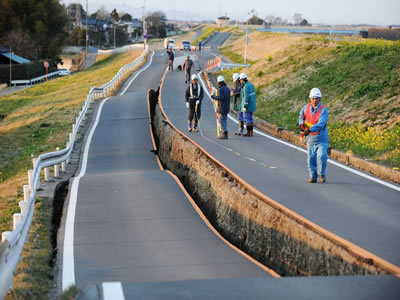
The Twin Disaster in Japan

Japan’s northeastern portion on the main island of Honshyu was hit by an 9-magnitude earthquake early afternoon on Friday, 11 March 2011, but the extensive quake damage was not the only disaster. Minutes later, a 10-meter tsunami struck the coastal areas, particularly Sendai City, destroying everything in its path. Both the quake and tsunami damaged a nuclear plant in Fukushima district, and an explosion later that day killed four workers trying to cool down an overheated reactor. The tidal wave intruded almost 10 kilometres (six miles) inland in certain areas and engulfed large tracts of arable land in the agriculturally rich prefectures of Iwate, Miyagi and Fukushima.
Quake footage was available almost instantly: office workers running outside as pieces of buildings fall to the ground; skyscrapers swaying like palms in a storm; pictures falling off walls; store shelves spilling to the floor. Technology has come a long way since the Indian Ocean tsunami of 2004, so footage of the disaster as it unfolded, was available in real time and spread rapidly across the internet and news networks,
The tsunami wiped out homes, businesses and a fishing industry that was the life force for thousands of victims on the northeast coast. It laid waste aquatic farms just offshore along with low-lying seaside areas that are home to fleets fishing along the coast, while the nuclear plant in Fukushima leaking radiation has raised concerns about marine life in the region over the longer term.
The total death toll now stands at 11,232 and 16,361 still missing and unaccounted for.
Early warning
As an earthquake strikes, early models of tsunamis are produced by millions of calculations and vast amounts of data-gathering which attempt to accurately predict the size and path of the wave. Much of this data is collected by tsunamographs, instruments that lie up to 5,000 metres below the water's surface, measuring changes in water pressure and transmitting information to nearby buoys.
The buoys then send this data, via satellite, back to warning centres. As the wave keeps on propagating, more and more tsunamograph recordings become available, so the forecast improves. However, even with these increasingly sophisticated techniques, there are still surprises. Often, due to inconsistencies in the sea bed and other natural variations, a tsunami can take a dramatically different course that defies all predictions.

Most warning systems primarily try to predict inundation and save people living along the coasts. There has been little effort to predict the height of tsunami waves and their effects on buildings and other structures like power plants as this was considered second priority. This tsunami will hopefully change that. Structures will have to be both quake and flood resistant at the same time and more attention needs to be paid to possible impacts on industrial facilities that provide vital services like power.
Response of NHK, Japan’s national broadcaster
Long before this twin tragedy, the NHK, the national broadcaster in Japan, had spent much time planning how to cover a crisis. It set up 460 remote cameras across the country, allowing for immediate footage of any disaster site. It integrated an emergency warning system that could warn of a quake seconds before a tremor hit. It mandated that a certain number of anchors live within five kilometers of the studio, so they could run to work if downtown Tokyo were crippled by a quake. Every night after the final newscast, NHK’s Tokyo bureau held a mock disaster drill, with backroom workers cuing up the meteorological warnings and on-air anchors barking them out. They held a similar drill every night at the Osaka bureau, just in case the people in Tokyo became trapped or unreachable.
Perhaps all of this preparedness felt redundant and bureaucratic until March 11. NHK was so quick to warn Japan of a tsunami that the network likely saved hundreds, maybe thousands of lives. These are the people who were watching NHK or turned it on when the earthquake struck at 2:46 p.m. NHK broke into its news coverage at 2:48 p.m., minutes before any other Japanese network. Already, the screen was loaded with emergency information.
In a sign of Japan's famed social cohesion and community commitment, survivors are forming volunteer groups and pitching in for relief work. The spirit of unity is reminiscent of Japan's last major quake in the western city of Kobe in 1995, regarded by many as a precious legacy born out of tragedy. In a volunteer movement that united the nation, more than 1.3 million people rushed to Kobe to fill gaps left by a sluggish government response. A similar mass volunteer movement is taking hold after this disaster, though authorities are for now stemming the influx of well-wishers from outside. They have called for restraint in the influx of volunteers to the affected area saying now is not the time and that volunteers will be much needed in the near future.
Costs of Damages
According to government estimates, the material damage from the magnitude 9.0 earthquake and the deadly tsunami could exceed $300 billion. That makes it the world's costliest disaster even without the further impact of power cuts and a drawn out struggle to contain the damage at the stricken nuclear plant. Japan plans to compile an emergency budget in cooperation with the opposition so that it can be passed in a divided parliament. Also, an earlier plan to cap corporate tax rate by 5% will now have to be reconsidered.
The IMF and the World Bank feels that Japan is capable of sustaining the losses incurred by this twin disaster. Japan's real GDP growth will slow, but the slowdown will likely be temporary. Growth should start picking up after mid-2011 as reconstruction efforts get underway, says World Bank officials talking to the media.
Even though the power shutdowns complicate prospects of a smooth recovery, the IMF believes that Japan’s economy is strong enough to afford the cost of rebuilding the damage from this twin disaster. Restoring power and government reconstruction spending were crucial to resuming growth, the IMF added.

Tokyo is also working on plans to provide low-interest loans of up to 10 trillion yen ($122 billion) to help companies recover from quake damage. The government also said that Tokyo would offer a total of 42,145 public housing units to victims of the earthquake and tsunami. The units include apartments for national civil servants and rental housing for low-income earners.
A Sea Wall that didn’t work

The residents of Taro, a small fishing town in the affected area, always felt protected by a seemingly impregnable sea wall of reinforced concrete that was the pride and symbol of Taro. But the huge wave swept over this 2.4 km long ‘Great wall of Japan’ and leveled everything in its path. Taro had borne the brunt of both 1896 and 1933 tsunamis and this wall was built in response to these tsunamis.
As well as seawalls, like the one at Taro, the eastern coast is dotted with other safeguards, such as offshore breakwaters and raised river dykes - complemented by sophisticated early warning systems. All these were apparently rendered impotent by the March 11 tsunami. The mayor of Minamisanriku, one of the hardest hit towns, has called for drastic change in policy and hinted at regulations that would put coastal areas off-limits to residential construction. But they have also realised that it is impossible to protect lives and property with hardware alone.
Some are of the opinion that a complacency had set in after frequent tsunami warnings, over the years, that resulted only in moderate to rough sea and waves. When faced with a tsunami that was bigger that what the nation, experts and local residents ever thought of and a mere upgradation of expectations is not enough, some feel.
Impact on India
Coastal Areas and Island territories
In the wake of the Japanese tsunami, concern for the safety of critical infrastructure projects situated along the Indian coast and those that have been planned for the coast, has led the MoEF to issue a press release that highlights the efforts of the MoEF to include disaster risks within Terms of Reference of the EIA framework. The ministry has also found it necessary to review current systems in place for assessing tsunami type risks as part of EIA of such projects.
The MoEF also highlights the Hazard Line Mapping system as an exercise that assumes special importance in view of tsunami like tragedies.
On the management of oceanic islands of Andaman Nicobar and Lakshadweep, the MoEF states that an Integrated Island Management Plan would be prepared for each of the 340 islands of A&N and 32 islands of Lakshadweep which takes into account natural disasters like tsunamis. An Expert Group is also being set up to evaluate what additional safeguards are needed for existing projects as well as to suggest measures to be taken for environmental impact assessment for projects to come up in future.
Nuclear Power Projects
The nuclear meltdown in Japan has raised concerns over the safety of Indian atomic power generators - particularly the one proposed at Jaitapur, located in a seismically sensitive area in Maharashtra. Besides the plants, the lack of autonomy and independence of the atomic regulatory body in India also came under flak from activists and the media. The cloak of secrecy over nuclear related issues and the justification for importing so many light water reactors were other issues raised.

The Prime Minister told media persons that steps would be taken to make the Atomic Energy Regulatory Board (AERB) truly autonomous and independent and suggested a need for greater openness and transparency in this regard. The government has already directed a technical review of all safety systems of power plants using the best available expertise adding that this will apply to all reactors and technologies – even those imported from abroad.
This twin disaster in Japan is a wake up call for India. Though we have a regulatory 500 meter buffer zone along our coasts, it is not strictly observed at all and our disaster preparedness is still a far cry from Japan. Besides mega disasters like tsunami and earthquakes, our coasts are ravaged regularly by floods, cyclones that can overrun our coastal cities, towns and villages. Serious cognizance of the CRZ and capacity building for disaster risk reduction are essential at all levels.
Those who live near industrial clusters along the coast, particularly nuclear power plants, must be drilled on disaster preparedness regularly. This could be made part of the mandatory disaster management activity of all industries. Mock drills must be implemented at all levels and steps taken to ensure compliance. Systematic training must be provided and state governments must take priority action in setting up and implementing the objectives of State Disaster Management Authorities.
More attention and resources must be focused on developing safer alternative sources like solar, wind and biogas instead of embarking on major nuclear expansions. Also, we have to rethink the way we consume, and generate power, and learn from the Fukushima disaster that is still unfolding before us.
Recent Blog
- Hats off to the government’s servants
- Thane Cyclone: An Indication For Re-visioning Disaster Management
- Tsunami lessons for Tohoku from Tamil Nadu
- TRINet Newsletter February 2012
- Cyclone Thane -- Disaster Preparedness and Response
- TRINet Newsletter January 2012
- Impact of ICT on Climate Change and Agriculture in India
- TRINet Newsletter July 2011
- TRINet Newsletter May 2011
- The End of Days for Endosulfan










